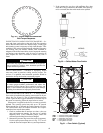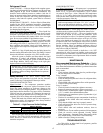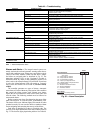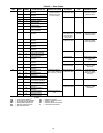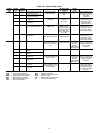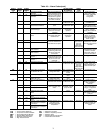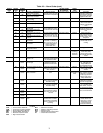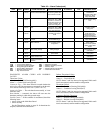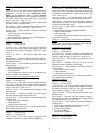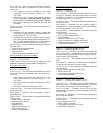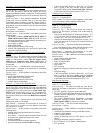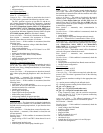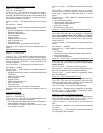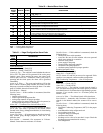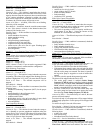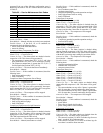
74
Alarm 10 — Master/Slave Common Fluid Thermistor
(th.11)
Criteria for Trip — This alarm criterion is tested whether the
unit is ON or OFF. The alarm will be tripped if the unit is
configured as a master or a slave (Master/Slave Select,
MSSL), leaving temperature control is selected (Entering
Fluid Control, EWTO), and if the temperature measured by
the CHWS (chilled water sensor) fluid sensor is outside the
range of –40 to 245 F (–40 to 118.3 C).
Action to be Taken — Master/slave operation is disabled and
the chiller returns to stand alone mode.
Reset Method — Reset is automatic when the thermistor read-
ing is inside the range of –40 to 245 F (–40 to 118.3 C).
Possible Causes — If this condition is encountered, check the
following items:
• sensor wiring to the Main Base Board
• a faulty thermistor
See the Thermistors section on page 56 for thermistor de-
scription, identifiers and connections.
Suction Gas Thermistor
Alarm 11 — Circuit A (th.12)
Alarm 12 — Circuit B (th.13)
Criteria for Trip — This alarm criterion is tested whether the
unit is ON or OFF. If the suction gas temperature as measured
by the thermistor is outside of the range –40 to 245 F (–40 to
118.3 C).
Action to be Taken — The affected circuit shuts down
normally.
Reset Method — Automatic, once the thermistor reading is
within the expected range. The affected circuit will restart once
the alarm has cleared.
Possible Causes — If this condition is encountered, check the
following items:
• sensor wiring to the EXV board
• board for a faulty channel
• a faulty thermistor
See the Thermistors section on page 56 for thermistor de-
scription, identifiers and connections.
Circuit Discharge Gas Thermistor Sensor Failure
Alarm 14 — Circuit A (th.15)
Alarm 15 — Circuit B (th.16)
Criteria for Trip — This alarm criterion is tested whether the
unit is ON or OFF. The alarm is tripped if the temperature
measured by the Outdoor Air Thermistor sensor is outside the
range of –40 to 245 F (–40 to 118.3 C).
Action to be Taken — The unit shuts down normally, or is not
allowed to start.
Reset Method — Automatic, the alarm will reset once the
thermistor reading is within the expected range.
Possible Causes — If this condition is encountered, check the
following items:
• sensor wiring to the CPM board
• a faulty thermistor
• a faulty channel on the board
See the Thermistors section on page 56 for thermistor descrip-
tion, identifiers and connections.
Condenser Subcooling Liquid Thermistor
Alarm 17 — Circuit A (th.18)
Alarm 18 — Circuit B (th.19)
NOTE: Alarms 17 and 18 are not used or supported. If this
condition is encountered, confirm machine configuration.
Alarm 19 — Space Temperature Sensor Failure (th.21)
Criteria for Trip — This alarm criterion is checked whether the
unit is ON or OFF and if Space Temperature Reset has been
enabled. This alarm is generated if the outdoor-air temperature
as measured by the thermistor is outside of the range –40 to
245 F (–40 to 118.3 C).
Action to be Taken — Unit operates under normal control.
Temperature Reset based on Space Temperature is disabled.
Reset Method — Automatic, once the thermistor reading is
within the expected range. The Space Temperature Reset will
resume once the alarm has cleared.
Possible Causes — If this condition is encountered, check the
following items:
• sensor wiring to the Energy Management Module
• board for a faulty channel
• a faulty thermistor
For thermistor descriptions, identifiers and connections, see
the Thermistors section.
Alarm 20 — Cooler Heater Feedback Sensor Thermistor
(th.23)
NOTE: Alarm 20 is not used or supported. If this condition is
encountered, confirm machine configuration.
Economizer Gas Thermistor
Alarm 21 — Circuit A (th.24)
Alarm 22 — Circuit B (th.25)
Criteria for Trip — This alarm criterion is tested whether the
unit is ON or OFF. The alarm is tripped if the Economizer gas
reading is outside the range of –40 to 245 F (–40 to 118.3 C).
Action to be Taken — The unit shuts down normally, or is not
allowed to start.
Reset Method — Automatic, the alarm will reset once the
thermistor reading is within the expected range.
Possible Causes — If this condition is encountered, check the
following items:
• sensor wiring to the EXV board
• a faulty thermistor
• a faulty channel on the board
See the Thermistors section on page 56 for thermistor descrip-
tion, identifiers and connections.
Discharge Transducer
Alarm 26 — Circuit A (Pr.01)
Alarm 27 — Circuit B (Pr.02)
Criteria for Trip — The criterion is tested whether the circuit is
ON or OFF. This alarm is generated if the voltage as sensed by
the MBB or Fan Board C (FBC) is 0 vdc, which corresponds
to the Navigator™ display of –7 psi (–48.3 kPa).
Action to be Taken — The circuit is shut down normally, or not
allowed to start.
Reset Method — Automatic, once the transducer voltage is
greater than 0 vdc, which corresponds to the Navigator display
of a value greater than –7 psi (–48.3 kPa).
Possible Causes — If this condition is encountered, check the
following items:
• sensor wiring to Main Base Board (Alarms 24 and 25)
• sensor wiring to Fan Board C (Alarm 26)
• board for a faulty channel
• for a faulty transducer
• confirm unit configuration
Suction Pressure Transducer Failure
Alarm 29 — Circuit A (Pr.04)
Alarm 30 — Circuit B (Pr.05)



